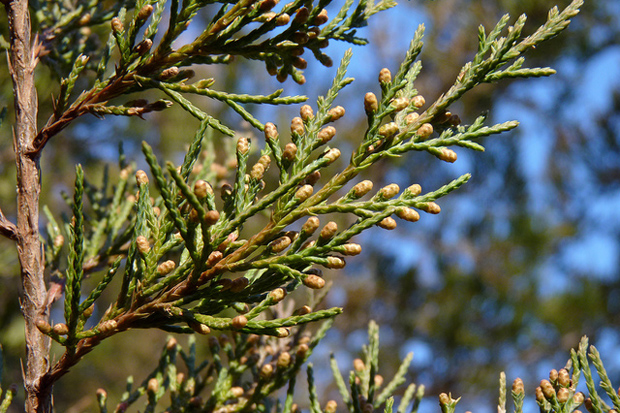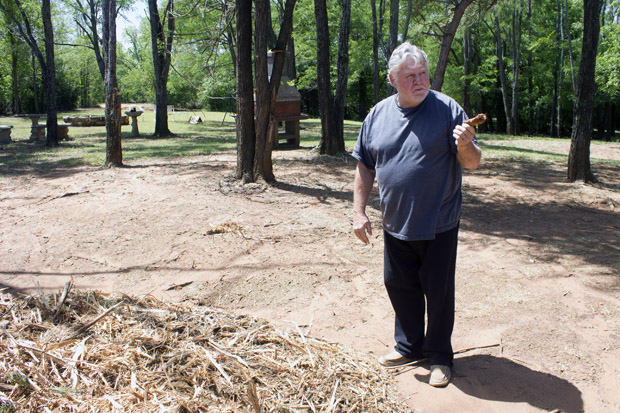
Legislature Studies Red Cedar Threat and Creative Ways To Fight Its Spread
-
Logan Layden

Joe Wertz / StateImpact Oklahoma
Homeowner Larry Huff holds a shard of Eastern Red Cedar, the handiwork of an Oklahoma County program that clears the flammable tree from private property.
The eastern red cedar tree’s bad reputation for fueling wildfires, hogging water, and disrupting ecosystems in Oklahoma is drawing the attention of state lawmakers, but so are ways to put the tree to use, like to help fight cancer.
As StateImpact has reported, the state does little to help local and county governments remove the trees that compound drought problems and appear to explode in all directions during fires.
Representative Richard Morrissette’s, D-Oklahoma City, wide-ranging interim study on the red cedar issue culminated at the capitol Tuesday with testimony from an array of water, wildlife, and forestry experts.
Home and business owners whose lives are directly affected by the trees, like Linda Agee of Shawnee, also weighed in.
“I’m a city commissioner, but I also happen to live on the Shawnee Twin Lakes. Unfortunately there are a lot of acres of undeveloped city-owned land around this lake that are becoming infested with red cedars. There are even some growing in the lakebed itself,” Agee told the lawmakers. “Being aware that the red cedar is a heavy water user, I contacted the city manager and some members of the city commission, and I was really surprised by the resistance I received on doing anything at all about this problem.”
Agee said she had to evacuate her home in 2010 during a red-cedar fueled fire in the area.
Cedar Solutions
The threat is severe — with hundreds of acres being lost to red cedars every day — but solutions can get very expensive. And that was the subject of Morrissette’s study: What more can be done to beat back the spread of eastern red cedars given the budget restraints on all levels of government?
There was testimony around creating a program that would use inmates to clear trees on public land. It’s cheap labor, similar programs already exist, and the training infrastructure is already in place in the form of CareerTech.
“We’ve obviously shown that we can do this utilizing energy — their energy — to clean up public areas of brush,” Morrissette said. “It seems like we could easily put inmates to work cutting trees — cutting cedars, specifically.”
Clearing Challenges
But often, red cedars grow in dangerous, steeply sloped areas people, prison inmates included, can’t safely access. Enter Steve Hart with the Langston University Goat Research Extension:
“The current project we have [is] cleaning a section of the canal there between Lake Overholser and Lake Hefner. There’s brush and trees on the steep banks. They need to control those, but basically it’s a work hazard,” Hart told lawmakers. “The goats are working to control that vegetation, and the public works department is very happy with what the goats are doing.”
Hart says goats cleared 90 percent of the red cedars off a plot of land in Kansas as part of his research a few years ago.
Having established that the trees need to go, the conversation then turned to what to do with the trees once they’re cut, from using them as fuel in biomass plants that would produce hot water for prisoners, to stimulating cedar supply chains and extracting a chemical from the tree’s leaves that goes into the chemotherapy drug Etoposide. The chemical is usually derived from the Indian may apple, which is now endangered.
Morrissette is expected to file a red cedar related bill next legislative session, as he did in 2014.
